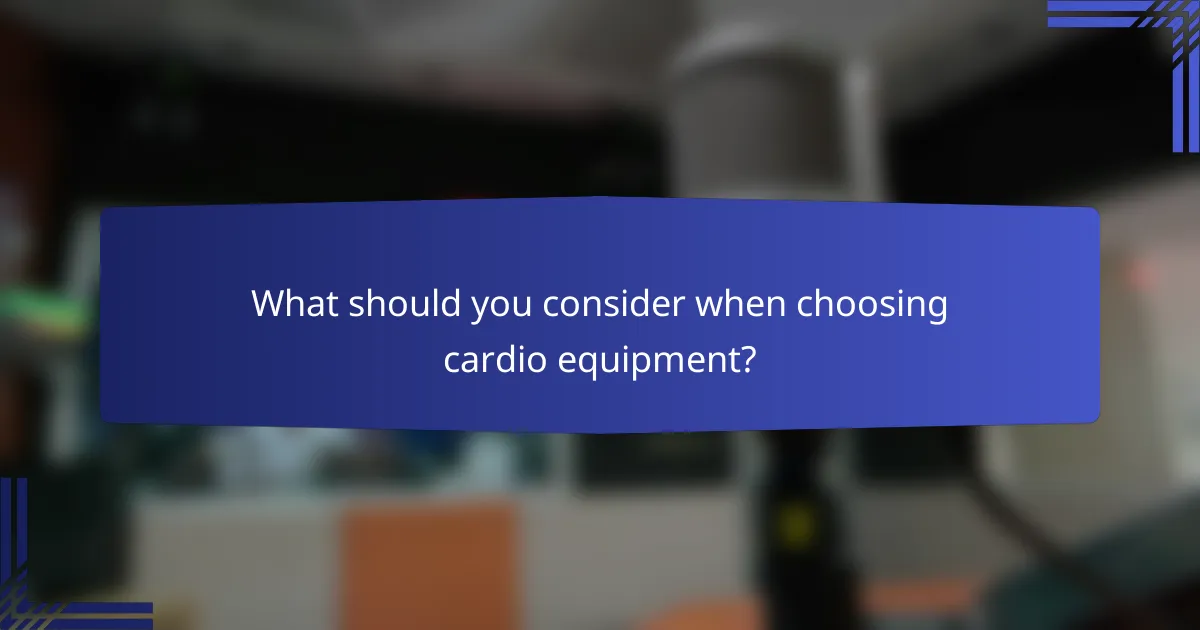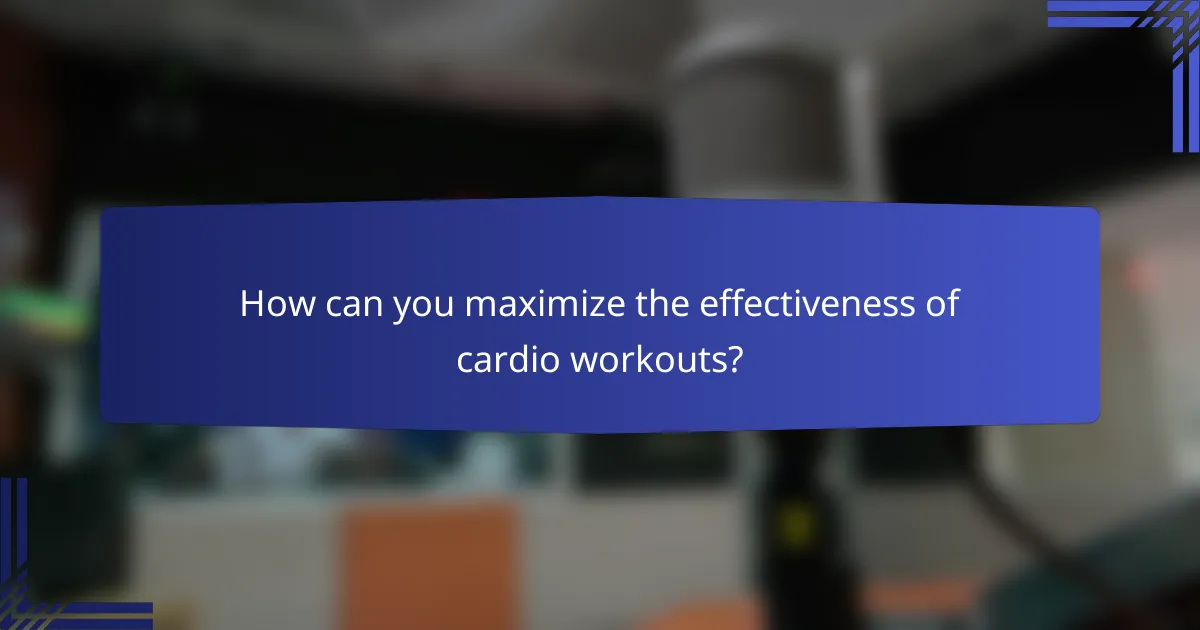Cardio equipment plays a crucial role in enhancing heart health by improving cardiovascular function and reducing the risk of heart disease. Regular use not only strengthens heart muscles and promotes better blood flow but also contributes to weight management and overall well-being, making it an essential part of any fitness routine.

How does cardio equipment impact heart health?
Cardio equipment significantly enhances heart health by improving cardiovascular function, reducing disease risk, and promoting overall fitness. Regular use of such equipment can lead to stronger heart muscles and better blood flow, which are essential for maintaining a healthy cardiovascular system.
Improves cardiovascular endurance
Using cardio equipment like treadmills, ellipticals, and stationary bikes helps build cardiovascular endurance by challenging the heart and lungs. This type of exercise increases the heart’s efficiency, allowing it to pump more blood with each beat and deliver oxygen to the muscles more effectively.
To improve endurance, aim for at least 150 minutes of moderate-intensity aerobic activity each week. Gradually increase the duration and intensity of your workouts to continue making progress.
Reduces risk of heart disease
Regular cardio exercise is linked to a lower risk of heart disease by helping to manage weight, lower blood pressure, and improve cholesterol levels. Engaging in aerobic activities can also reduce inflammation and improve insulin sensitivity, both of which are important for heart health.
To maximize these benefits, incorporate a variety of cardio workouts into your routine, such as interval training and steady-state cardio, to keep your heart challenged and engaged.
Enhances blood circulation
Cardio equipment promotes better blood circulation by increasing heart rate and stimulating blood flow throughout the body. Improved circulation ensures that vital nutrients and oxygen reach all tissues, which is crucial for overall health and recovery.
For optimal circulation, include exercises that elevate your heart rate for sustained periods, such as cycling or running. Regular sessions can lead to noticeable improvements in how your body feels during daily activities.
Supports weight management
Cardio workouts are effective for weight management as they burn calories and help create a caloric deficit. This is essential for losing weight or maintaining a healthy weight, which directly impacts heart health.
To effectively manage weight, combine cardio with strength training and a balanced diet. Aim for a mix of high-intensity and moderate-intensity workouts to keep your metabolism active and support long-term weight goals.

What are the benefits of using cardio equipment?
Using cardio equipment offers numerous benefits for heart health, including improved cardiovascular fitness, weight management, and enhanced overall well-being. Regular use can lead to significant health improvements, making it a vital component of a balanced fitness routine.
Boosts mental health
Cardio equipment can significantly boost mental health by releasing endorphins, which are natural mood lifters. Engaging in regular cardiovascular exercise can help reduce symptoms of anxiety and depression, promoting a more positive outlook on life.
Activities like running on a treadmill or cycling can also serve as a form of stress relief. Many users report feeling more relaxed and focused after a cardio session, making it an effective way to manage daily stressors.
Increases energy levels
Using cardio equipment regularly can lead to increased energy levels throughout the day. This is partly due to improved cardiovascular efficiency, which enhances blood flow and oxygen delivery to muscles and organs.
Incorporating short sessions of cardio, such as 20-30 minutes on an elliptical or stationary bike, can provide an immediate energy boost. Over time, consistent use can help combat fatigue and improve overall stamina.
Improves sleep quality
Regular cardio exercise is linked to better sleep quality, helping individuals fall asleep faster and enjoy deeper sleep cycles. Engaging in activities like jogging or using a rowing machine can help regulate sleep patterns.
For optimal results, aim to complete cardio workouts at least a few hours before bedtime, as exercising too close to sleep can sometimes have the opposite effect. Establishing a routine can lead to long-term improvements in sleep health.

Which types of cardio equipment are best for home use?
The best types of cardio equipment for home use include treadmills, stationary bikes, and ellipticals. Each offers unique benefits and can cater to different fitness levels and preferences, making them suitable for various workout routines.
Treadmills for versatile workouts
Treadmills are ideal for simulating outdoor running or walking, providing a versatile workout option. They often come with adjustable speeds and inclines, allowing users to customize their intensity levels. This equipment is suitable for both beginners and advanced users, making it a staple in many home gyms.
When using a treadmill, consider incorporating interval training to maximize calorie burn and improve cardiovascular fitness. Aim for sessions of 20-30 minutes, adjusting the speed to maintain a challenging yet manageable pace.
Stationary bikes for low-impact exercise
Stationary bikes are excellent for low-impact cardiovascular workouts, making them a great choice for individuals with joint issues or those recovering from injuries. They provide a solid aerobic workout while minimizing stress on the knees and hips.
For effective use, aim for 30-60 minutes of cycling, adjusting the resistance to match your fitness level. Consider using a recumbent bike for added back support or an upright bike for a more traditional cycling experience.
Ellipticals for full-body engagement
Ellipticals offer a full-body workout by engaging both the upper and lower body, making them efficient for burning calories. The smooth, gliding motion reduces impact on the joints, suitable for users of all fitness levels.
To optimize your elliptical workouts, aim for sessions of 20-40 minutes, incorporating varying resistance levels. This not only keeps the workout interesting but also enhances muscle engagement and cardiovascular benefits.

What should you consider when choosing cardio equipment?
When selecting cardio equipment, consider factors such as space, budget, and the specific health benefits you seek. The right choice can enhance your workout experience while fitting seamlessly into your lifestyle.
Space and storage requirements
Evaluate the available space in your home for cardio equipment. Compact machines like folding treadmills or stationary bikes are ideal for smaller areas, while larger equipment like ellipticals may require more room. Ensure you have enough space not just for the equipment itself, but also for safe movement around it.
Consider storage options as well. Some machines can be easily stored away when not in use, while others are designed to be more permanent fixtures. If space is limited, look for equipment that can be easily disassembled or folded for storage.
Budget and pricing options
Your budget significantly influences your choice of cardio equipment. Prices can range from a few hundred to several thousand dollars, depending on the type and features. Basic models typically start around $200, while high-end machines with advanced technology can exceed $2,000.
Look for sales or financing options to make your purchase more manageable. Additionally, consider the long-term investment; higher-priced equipment may offer better durability and features that enhance your workout experience, potentially saving you money in the long run.

How can you maximize the effectiveness of cardio workouts?
To maximize the effectiveness of cardio workouts, focus on incorporating varied intensity levels, setting realistic goals, and maintaining consistency. These strategies enhance cardiovascular health, improve endurance, and promote weight management.
Incorporate interval training
Interval training alternates between high-intensity bursts and lower-intensity recovery periods, making workouts more efficient. This method can significantly boost cardiovascular fitness and calorie burn in a shorter time compared to steady-state cardio.
For example, during a 30-minute session, you might sprint for 1 minute followed by 2 minutes of walking. Aim for a ratio of 1:2 or 1:3 for effective intervals. This approach can be adapted to various cardio equipment like treadmills, bikes, or rowing machines.
Set achievable fitness goals
Setting achievable fitness goals helps maintain motivation and track progress. Goals should be specific, measurable, and time-bound, such as aiming to run a certain distance within a set timeframe or increasing workout frequency to four times a week.
Consider using the SMART criteria: Specific, Measurable, Achievable, Relevant, and Time-bound. For instance, instead of saying “I want to get fit,” specify “I will run 5 kilometers in under 30 minutes within three months.” This clarity can guide your cardio routine effectively.

What are common mistakes to avoid with cardio equipment?
Avoiding common mistakes with cardio equipment is essential for maximizing your workout effectiveness and ensuring safety. Key pitfalls include neglecting proper form and overtraining without adequate rest.
Neglecting proper form
Proper form is crucial when using cardio equipment to prevent injuries and enhance performance. For instance, when using a treadmill, maintain an upright posture and avoid leaning too far forward or backward. This helps in engaging the right muscle groups effectively.
Additionally, pay attention to your foot placement and stride length. A common mistake is taking overly long strides, which can lead to strain. Instead, aim for a comfortable, natural stride that feels sustainable over time.
Overtraining without rest
Overtraining occurs when you push your body too hard without allowing for recovery, leading to fatigue and decreased performance. It’s important to incorporate rest days into your cardio routine, especially after intense sessions. Aim for at least one to two rest days per week, depending on your fitness level.
Listening to your body is key. Signs of overtraining include persistent fatigue, irritability, and decreased performance. If you notice these symptoms, consider reducing the intensity or frequency of your workouts to allow your body to recover properly.

How does cardio equipment compare to outdoor cardio?
Cardio equipment offers a controlled environment for cardiovascular workouts, while outdoor cardio provides natural scenery and fresh air. Both have unique benefits, but the choice often depends on personal preference, weather conditions, and specific fitness goals.
Weather-independent workouts
Using cardio equipment allows for consistent workouts regardless of weather conditions. Rain, snow, or extreme heat won’t disrupt your routine when you have access to a treadmill, stationary bike, or elliptical machine.
Indoor cardio options can be particularly beneficial for those living in regions with harsh climates or unpredictable weather patterns. This predictability helps maintain a regular exercise schedule, which is crucial for achieving fitness goals.
To maximize your indoor cardio sessions, consider setting specific targets, such as duration or intensity, and use apps or fitness trackers to monitor your progress. This approach can help keep you motivated and accountable, even when the weather outside is less than ideal.
